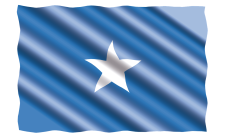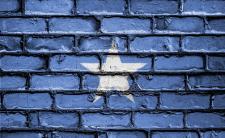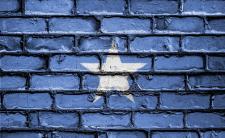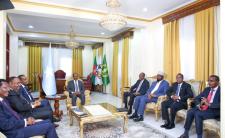Last updated in August 2018
A Brief Background Constitutional History
Modern Somalia emerged from the reunification of two territories—British Somaliland and the former Italian Somaliland—at independence in 1960. The independence constitution, drafted in 1960 and approved in a referendum in 1961, established a parliamentary system of government. Following a coup d’état led by Major General Mohamed Siad Barre in 1969, this constitution and its institutions were suspended until 1979 when a new constitution was drafted and approved via referendum. The Constitution of 1979 established a presidential system of government. However, power remained concentrated in Barre’s military regime—amidst growing clan-based internal conflict— until an internal Somali rebellion overthrew the regime in 1991.
The demise of the Barre regime resulted in the collapse of the Somali state: clan-based structures emerged, and seized and controlled parts of the national territory. The northwest former British protectorate broke away and declared itself as an independent—though yet to be internationally recognized— Republic of Somaliland. Puntland in the northeastern region declared itself as an autonomous state.
For most of the two decades following the overthrow of the Barre regime, Somalia remained a country largely without a central governing authority and characterized by clan-based politics, and internal armed conflict between the different clans and factions, including groups driven by religious extremism, such as Al Shabaab.
Restoring peace, rebuilding the state, and constitution-making between 1991 and 2018
Somalia’s disintegration and the ensuing internal conflicts attracted significant regional and international efforts to end the war, restore peace and rebuild the state. Most of this was largely conducted under the auspices of the Intergovernmental Authority on Development (IGAD), an eight-country regional bloc comprising Djibouti, Ethiopia, Eritrea, Kenya, Somalia, South Sudan, Sudan and Uganda. Tied to the peace and state building processes was also attempts to re-establish some form of constitutional order. The most important of such attempts was the adoption of a Transitional National Charter (TNC) in 2000. An outcome of the Arta [Djibouti] Peace Conference, the Charter established a decentralized unitary state based on regional autonomy. It also set up a Transitional National Government (TNG) and a power sharing arrangement based on a so-called 4.5 formula. Under this formula, Somalia’s four main clan families, namely the Darood, Dir, Hawiye and the Rahanwein/Digil-Mirifle, each get equal stake in political representation while the other ‘minority’ clans together share a 0.5 stake. Furthermore, it recognized the de facto regional autonomy of states such as Puntland.
In 2004, following further peace talks in Kenya, and in an attempt to strengthen and consolidate the authority of the central state, which remained weak under the TNG, Somali stakeholders agreed on a new constitutional blueprint. The Transitional Federal Charter (TFC), as it was titled, formally established a federal system for Somalia to replace the decentralized unitary system of the TNC. It also provided for a Transitional Federal Parliament (TFP) and a Transitional Federal Government (TFG). Furthermore, the Charter authorized the establishment of a Federal Constitutional Commission (FCC) with a mandate to draft a federal constitution based on the principles outlined in the Charter. The FCC, once established, was initially expected to finalize the constitution within two and half years.
In June 2006, Parliament adopted the legal framework to govern the constitution making process. The Somali Constitutional Commission Act, as it was called, established a fifteen-member FCC in line with the 4.5 formula, and elaborated the principles to guide the Commission’s work. The Act required the Commission to take account of the Charter, the principles of Islam, democracy and social justice, and to ensure a process that (a) promotes public participation, transparency and accountability to the people; (b) accommodates the diversity of Somalis and their opinions; and (c) promotes stability, peace and reconstruction.
In August 2006, the FCC held its first meeting, where it adopted its rules of procedure, outlined a civic education programme and a roadmap for producing the draft constitution. The body also renamed itself as the ‘Independent’ Federal Constitutional Commission (IFCC). As the FCC was only set up in mid-2006, and considering the two and half year mandate provided for in the TFC, the expectation, in theory, was that the FCC was to finish its work by December 2008.
However, due to increased insecurity and violence, the Commission never effectively commenced its work until March 2010. In August 2010, it released a preliminary Consultation Draft Constitution (CDC). The document outlined options and ideas to stimulate public debate and inputs to inform a more concrete draft. Between 2010 and 2011, the Commission engaged in civic education and public consultation on the draft document in fraught conditions of insecurity and political instability. This meant limited outreach and further delays. Thus, it was not until August 2012 that a new constitution was ‘provisionally’ adopted by a National Constituent Assembly (NCA) comprising 825 members representing different sections of the Somali society, in lieu of a referendum, which was anticipated but was impractical under the security circumstances. Its adoption marked the ‘end’ of an eight-year transition defined by political turmoil, warfare, instability and delays to the constitution making process.
The ‘Provisional’, rather than ‘Permanent’, character of the 2012 Constitution must be understood in two senses. Firstly, the TFC required the final constitution to be adopted through a referendum but security conditions made this impossible. It was thus agreed that the document only be ‘provisionally’ approved through the NCA until security conditions allow the possibility of a nationwide constitutional referendum to take place. Second, because stakeholders could not agree on all key state-building questions, members of the IFCC considered their work as unfinished, and therefore provided for a second transitional period during which these unresolved issues should be addressed before finally submitting the document to a referendum. Key amongst the issues in question were the:
- Structure of the federal legislature, executive and the judiciary;
- Division of power and resources between the federal and the state governments; and
- The status of Mogadishu.
Chapter 15 of the Provisional Constitution deals with the second aspect, i.e. the continuation of the constitution review process and constitutional amendment in general. While the Provisional Constitution lacks clarity on the way forward in relation to large scale constitutional revision, a confusion emanating from the failure to comply with timelines, regular amendments can be triggered by the federal government, state governments, the federal Parliament or through popular petition. A joint committee of both houses of parliament reviews all proposals. Once accepted, they must be adopted by at least 2/3rd majority vote in both houses of Parliament and a simple majority in a public referendum.
In recognition of the unfinished work of the IFCC, the Constitution establishes two institutions to pursue reforms. These are a Provisional Constitution Implementation and Oversight Committee (OC), which is a parliamentary body, and an Independent Provisional Constitutional Review and Implementation Commission (IC), which is an independent expert body. It also tied the duration of this second transition to the term of the first Parliament which was four years (2012-2016). In practice, this meant that all contentious issues not resolved by the IFCC should have been finalized and a constitutional referendum held by August 2016.
However, various challenges— including delays in establishing the OC and the IC and defining their roles— meant that by the time both bodies could set to work and propose options on the contentious issues, it was too late for parliament to debate it as its term was expiring.
A new parliament and government has been installed since 2017 with the leadership promising to finalize the process before the 2020 elections and as early as the end of 2018. It remains unclear how the process will unfold from here onwards. As this article argues, the failure to respect constitutional timelines creates potentially problematic process-related legal implications that would need to be resolved in order to move the process forward smoothly. In the meantime, the Provisional Constitution, adopted in August 2012, remains the governing framework of Somalia.
Other institutional arrangements under the Provisional Constitution
In summary, the Constitution, which recognizes federalism as the principle for organizing and structuring the state, comprises 143 articles grouped into 15 chapters. It establishes a two-tier government—at the central level and the state level, and also formally recognizes the principle of local government without granting the latter the status of a third tier of government. Furthermore, it establishes a republican political system with a unique system of government combining a president selected by parliament but is not politically accountable to it (the same way presidents in assembly-independent systems are selected and operate) and also provides for a prime minister elected by and accountable to parliament. This section profiles only the institutional arrangements for the national or federal government.
The federal executive and government
The Constitution establishes a dual executive consisting of a President and a Prime Minister. The former is elected as Head of State in a joint session of the two houses of the federal Parliament for a four-year term. There is no prohibition against reelection. The President enjoys a range of competences including being commander of the armed forces, granting pardons, promulgating and/vetoing proposed laws, declaring a state of emergency, appointing the chair of the constitutional court and senior members of government (except ministers) including the Prime Minister. Although appointed by parliament, the president is not subject to a political vote of no confidence and may only be removed through an impeachment procedure for treason or other gross violation of the constitution or the laws of Somalia. An impeachment initiative is submitted to the Constitutional Court by at least 1/3rd of the members of the lower house of parliament. If the Court determines that there are legal grounds for impeachment, the president can be removed by at least 2/3rd of the total membership in a joint session of the two houses of parliament.
The Prime Minister heads the government and the Council of Ministers, in which the executive power of the federal government is vested. S/he appoints and recommends the dismissal of ministers and deputy prime ministers by the president. The Prime Minister and his/her cabinet must receive the vote of confidence (50%+1) of the members of the lower house of parliament and can be removed through a no confidence vote.
The federal legislature
The Federal Parliament is bicameral, comprising an Upper House composed of an equal number of delegates from each member state representing the interests of states and a lower house or House of the People. Parliament has full lawmaking powers, which it also shares with the government, as the latter reserves the exclusive power to initiate money bills. The lower house of parliament can also trigger the dissolution of the government through a vote of no confidence. This effectively gives it oversight powers over government activities, which in turn ensures that the government remains accountable and answerable for its actions before parliament.
The Judiciary
Chapter 9 vests judicial authority in the courts, which the Constitution lists as including the Constitutional Court, the Federal Government level courts and the Federal Member state level courts. The highest appellate court on non-constitutional questions at the federal level is the Federal High Court and Federal Member State high courts at the state level. The Constitutional Court has exclusive competence on questions related to the federal constitution as well as on disputes between national and states governments and between organs of the national government. The Court has five members, including the Chief Judge appointed by the President after approval in the lower house of parliament based on nominations of the judicial service commission. Although the Constitution indicates that the Upper House is involved in the appointment process, it does not specify at what stage. The judges select the Chief Judge from among themselves.
While the constitution does not create a centralized judicial system (except on matters of constitutional interpretation), it remains unclear whether the intention is to create an integrated system of courts (where federal government level courts and federal member state level courts both decide cases arising from state and federal law) or dual [separate] system of courts (where the jurisdiction of federal and state courts is restricted to breaches to federal and state laws, respectively).
System of federal government under the Provisional Constitution
Timeline
- July 1960: Somalia achieves independence following reunification of British and Italian Somaliland.
- June 1961: Independence constitution, establishing a unitary state and a parliamentary system is finalized and approved in a constitutional referendum.
- October 1969: General Mohamed Siad Barre overthrows the civilian government, installs military rule and suspends the Constitution for ten years.
- August 1979: Constitutional rule is restored, following the adoption of a new constitution. General Barre stays on as President winning all elections organized under the Constitution amidst growing internal opposition to his, increasingly, authoritarian rule from different armed groups and Somali clans.
- January 1991: General Barre is deposed and flees Mogadishu resulting in state collapse. Somaliland in the northwest breaks away to form the independent republic of Somaliland, while Puntland in the northeast declares itself autonomous.
- August 2000: Djibouti [Arta] Peace Process results in a Transitional National Charter (TNC), a Transitional National Government and the 4.5 political representation formula.
- February 2004: Transitional Federal Charter (TFC) approved to replace TNC. TFC establishes transitional federal institutions, including a Transitional Federal Government (TFG) and a Transitional Federal Parliament (TFP). It also establishes a Federal Constitutional Commission and tasks it with drafting a federal constitution.
- June 2006: Somali Constitutional Commission Act is adopted by the TFP to set up the FCC.
- August 2006: FCC holds its first meeting. Adopts its rules of procedure, a plan for civic education and consultation; and a roadmap for completing the drafting process. It also adds ‘Independent’ to its name thus transforming it into the IFCC.
- December 2006: The Islamic Courts Union, which had briefly controlled the country, is defeated by the Transitional Federal Government, with the support of the Ethiopian army, allowing the latter to enter Mogadishu unopposed. A group within the armed wing of the ICU forms Al Shabaab.
- Late 2006-Early 2010: Increased insecurity, including assassination of the Minister of Constitutional Affairs, forces the IFCC to halt its work.
- March 2010 – 2011: FCC resumes its work and produces a Consultation Draft Constitution outlining options and ideas to stimulate public debate and opinion, which take place between late 2010 and early 2011.
- August 2012: Draft Constitution is ‘provisionally’ adopted by a National Constituent Assembly (pending a nationwide referendum) as a Provisional rather than Final Constitution— firstly because it leaves certain key contentious issues to be resolved downstream by two separate institutions, and secondly because the approval mechanism falls short of the referendum requirement provided in the legal framework governing the process.
- June & Dec 2014: The Provisional Constitution Implementation and Oversight Committee (OC) and the Independent Provisional Constitutional Review and Implementation Commission (IC) charged under chapter 15 of the Provisional Constitution, to amend the Constitution and to finalize contentious issues are set up.
- March 2015: The OC and the IC sign MoU with the Ministry of Constitutional Affairs defining their roles and responsibilities.
- July 2016: The OC and the IC finalize draft options for amending the Provisional Constitution as Parliament is dissolved in preparation for new elections. The absence of a sitting Parliament to debate the draft in line with the chapter 15 procedure means the August 2016 deadline for finalizing the process is missed and the process is automatically suspended.
- Oct & Nov 2016: Elections for a new Parliament held.
- February 2017: New Parliament meets and elects the President of the Republic.
- May 2018: The constitutional review process is relaunched during a National Constitutional Convention attended by 350 delegates drawn from across Somalia. Participants discuss the next steps in the process. The government pledges $3 million to support the process and the UN pledges to raise more funds to add to the amount. The President promises to speed up the process and finalize the Constitutional amendment process before the next elections in 2020.
Bibliography:
- Provisional Constitution of Somalia, 1 August 2012, http://hrlibrary.umn.edu/research/Somalia-Constitution2012.pdf
- Consultation Draft Constitution of the Somali Republic (IFCC, July 2010) http://somalitalkradio.com/2010/aug/draft_constitution_english.pdf
- Transitional Federal Charter of the Republic of Somalia, February 2004, http://www.ilo.org/dyn/travail/docs/2177/Transitional%20Federal%20charter-feb%202004-English.pdf
- Somali President Promises to deliver new Constitution before next elections, Relief Web, May 2018 https://reliefweb.int/report/somalia/somali-president-promises-deliver-new-constitution-next-elections
- Somali constitutional review project launched as historic convention concludes in Mogadishu, UN, May 2018 http://www.so.undp.org/content/somalia/en/home/presscenter/pressreleases/2018/05/15/historic-3-day-convention-on-somali-constitution-concludes-in-mogadishu.html
- Ahmed, A. Hirsi, Constitution Making in Somalia: A Critical Analysis, 1960-2013 (2012) http://erepository.uonbi.ac.ke/bitstream/handle/11295/74749/Ali_Constitution-making%20in%20Somalia%3A%20a%20critical%20analysis%2C%201960%20%E2%80%93%202013.pdf?sequence=3&isAllowed=y
- Jan Schmidt, Somali Constitutional Review Process: Taking Stock, ConstitutionNet , March 2018 http://www.constitutionnet.org/news/somali-constitutional-review-process-taking-stock
- Issa Salwe, Adbdisalam, Somali Peace Concerns and Arta Outcome (undated) https://www.scribd.com/document/13250437/Somali-Peace-Concerns-and-Arta-Outcome
[1] Direct elections are yet to be organized
| Branch | Hierarchy | Appointment | Powers | Removal | ||||||||
|---|---|---|---|---|---|---|---|---|---|---|---|---|
| Executive |
|
|
|
|
||||||||
| Legislative |
|
|
|
|
||||||||
| Judicial |
|
|
|
|
Executive
President
Appointment
Elected by federal parliament (Upper House and House of the People) for renewable four-year terms.
Powers
- Head of the state;
- Supreme Commander of the armed forces;
- Appoints and dismisses the commanders of federal forces on the recommendation of the Council of Minsters;
- Appoints Prime Minister;
- Appoints members of the judiciary;
- Appoints and accredits ambassadors;
- Grants judicial pardons;
- Promulgates or vetoes laws;
- Declares state of emergency and wars;
- Dismisses ministers and state ministers on recommendation of the Prime Minister;
- Dissolves the government in case of a parliamentary vote of no confidence.
Removal
- At the end of a four year term, with the possibility of one renewal
- At the expiration of the term of the legislature
- Upon removal from office by the legislature after a conviction by the Supreme Court for perjury, violation of the Constitution, or high treason
Prime Minister
Appointment
- Appointed by the President.
Powers
- Head of Government;
- Appoints deputy prime ministers and ministers;
- Presides over the Council of Ministers;
- Proposes appointments or dismissals of ambassadors and consuls;
- Presents and defends the government’s program to parliament.
Removal
- Dismissal following a vote of no confidence by the lower house of parliament.
President
Appointment
Elected by federal parliament (Upper House and House of the People) for renewable four-year terms.Powers
- Head of the state;
- Supreme Commander of the armed forces;
- Appoints and dismisses the commanders of federal forces on the recommendation of the Council of Minsters;
- Appoints Prime Minister;
- Appoints members of the judiciary;
- Appoints and accredits ambassadors;
- Grants judicial pardons;
- Promulgates or vetoes laws;
- Declares state of emergency and wars;
- Dismisses ministers and state ministers on recommendation of the Prime Minister;
- Dissolves the government in case of a parliamentary vote of no confidence.
Removal
- At the end of a four year term, with the possibility of one renewal
- At the expiration of the term of the legislature
- Upon removal from office by the legislature after a conviction by the Supreme Court for perjury, violation of the Constitution, or high treason
Prime Minister
Appointment
- Appointed by the President.
Powers
- Head of Government;
- Appoints deputy prime ministers and ministers;
- Presides over the Council of Ministers;
- Proposes appointments or dismissals of ambassadors and consuls;
- Presents and defends the government’s program to parliament.
Removal
- Dismissal following a vote of no confidence by the lower house of parliament.
Legislative
House of the People
Appointment
- 275 members elected by direct universal suffrage for renewable four-year terms.
Powers
- Participates in the constitutional amendment process;
- Participates in the process of electing and dismissing the President of the Republic;
- Participates in the process of amending, approving or rejecting bills;
- Examines laws passed by the Upper House;
- Approves nominations into the judiciary;
- Delegates within permissible limits legislative authority to the Upper House;
- Provides legislative oversight and control of government activities through votes of censure;
- Approves or rejects the government programme.
Removal
- Dissolution in case of inability to approve Council of Ministers and government programme.
Upper House
Appointment
- 54 members elected by direct universal suffrage by the people of each federal member state in equal numbers.
Powers
- Participates in the election and dismissal of the president of the republic;
- Shares lawmaking functions to the extent permitted by the Constitution with the House of the People;
- Participates in the process of declaring war and states of emergency in line with the Constitution;
- Participates in the appointments process of members of certain government institutions and commissions
Removal
- The Constitution does not anticipate the dissolution of the Upper House.
House of the People
Appointment
- 275 members elected by direct universal suffrage for renewable four-year terms.
Powers
- Participates in the constitutional amendment process;
- Participates in the process of electing and dismissing the President of the Republic;
- Participates in the process of amending, approving or rejecting bills;
- Examines laws passed by the Upper House;
- Approves nominations into the judiciary;
- Delegates within permissible limits legislative authority to the Upper House;
- Provides legislative oversight and control of government activities through votes of censure;
- Approves or rejects the government programme.
Removal
- Dissolution in case of inability to approve Council of Ministers and government programme.
Upper House
Appointment
- 54 members elected by direct universal suffrage by the people of each federal member state in equal numbers.
Powers
- Participates in the election and dismissal of the president of the republic;
- Shares lawmaking functions to the extent permitted by the Constitution with the House of the People;
- Participates in the process of declaring war and states of emergency in line with the Constitution;
- Participates in the appointments process of members of certain government institutions and commissions
Removal
- The Constitution does not anticipate the dissolution of the Upper House.
Judicial
Constitutional Court
Appointment
- Comprises five judges appointed by the President of the Republic, following their nomination and approval by the Judicial Service Commission and House of the People, respectively.
Powers
- Decides cases on the interpretation of the Constitution;
- Decides disputes between the organs of the federal government (horizontal disputes);
- Decides cases between the federal government and federal member state governments (vertical disputes);
- Hears and decides cases concerning the impeachment of the President of the Republic;
- Determines challenges to the constitutionality of laws and draft laws.
Removal
- Dismissal of members on recommendation from the Judicial Service Commission following a disciplinary procedure.
Federal High Courts
Appointment
- Appointment process same as above.
Powers
- Determines appeals from lower federal courts on the interpretation of all federal laws.
Removal
- Removal process same as above.
Constitutional Court
Appointment
- Comprises five judges appointed by the President of the Republic, following their nomination and approval by the Judicial Service Commission and House of the People, respectively.
Powers
- Decides cases on the interpretation of the Constitution;
- Decides disputes between the organs of the federal government (horizontal disputes);
- Decides cases between the federal government and federal member state governments (vertical disputes);
- Hears and decides cases concerning the impeachment of the President of the Republic;
- Determines challenges to the constitutionality of laws and draft laws.
Removal
- Dismissal of members on recommendation from the Judicial Service Commission following a disciplinary procedure.
Federal High Courts
Appointment
- Appointment process same as above.
Powers
- Determines appeals from lower federal courts on the interpretation of all federal laws.
Removal
- Removal process same as above.





